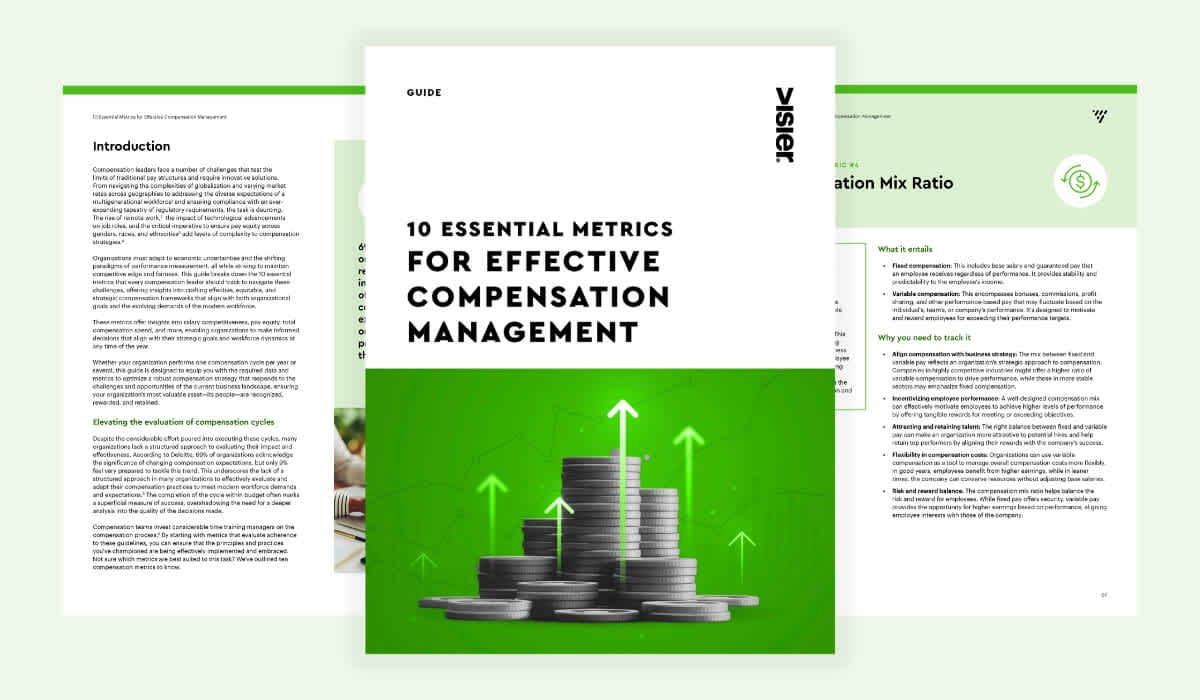How to Create a Strategic Compensation Strategy
Strategic compensation ensures transparent and fair pay for all employees while helping you stay competitive, and attract, and retain top talent. Learn more.

Compensation is one of the key elements of employee satisfaction and business success. Not too long ago, a fair paycheck was all you had to offer. But things have now changed. Employees want more than a competitive wage—they want equity, transparency, and other benefits. A strategic compensation strategy is the way to make that happen.
With it, you can manage total employee compensation in a way that ensures you remain competitive. Strategic compensation can help you attract top talent and retain employees. So let’s take a look at what strategic compensation is and how you can create such a strategy.
What is strategic compensation?
Strategic compensation is a human resource management technique that helps companies manage the total employee compensation. It ensures growth, equity, and transparency while helping businesses save money, stay competitive, and boost overall performance.
Strategic compensation also allows companies to establish reward systems that will increase employee retention. For example, you can use it to create merit increase programs for top performers.
Why is strategic compensation important?
Strategic compensation helps you attract top talent and maintain a competitive advantage. An effective strategic compensation strategy helps to ensure pay equity and allows companies to be more transparent with employees regarding compensation amounts and raises. It is also useful when navigating through difficult times such as a recession or a pandemic by making costs easier to track over time.
Here are the main ways in which strategic compensation can help.
Attract top talent with ease.
Employees care about transparency and fairness when it comes to compensation. Strategic compensation can help you meet the market and offer benefits that will attract the best people for your company.Retain top performers.
Your efforts to have top performers in your company don’t stop once the hiring process is over. On the contrary,retention is just as important. People who feel they’re not rewarded for their efforts will leave sooner or later. Strategic compensation can help you offer the correct rewards at the right time. It can also show you when merit increases are due to help you stay competitive.Improve the overall performance.
Employees who feel satisfied with their job and the compensation they receive are more likely to perform better.

8 steps to create a strategic compensation strategy
Creating a strategic compensation strategy requires the following steps:
Assess your current compensation strategy
Gather feedback from your employees
Conduct market studies
Know your budget
Establish pay grades
Ensure legal compliance
Plan for rewards and bonuses beyond the salary
Communicate your strategy
Let’s take a look at each of them.
1. Assess the current compensation strategy
You can’t create a new strategy without analyzing the current one. To do so, ask questions like:
How are you determining the current pay ranges?
Are there any reward systems in place? If yes, what are your criteria? Is it accessible to everyone?
Is the compensation you offer competitive? How does it relate to the market ranges?
Is the current strategy aligned with the company’s budget?
What are the types of compensation you’re currently offering? Are you only focused on financial incentives? Is there room for different types of rewards?
If this is the first time you’re thinking of strategic compensation, you might not have an official strategy in place. In this case, run a salary audit. Try to see if the remuneration you’re offering meets the market, is compliant with local regulations, and more.
2. Gather employee feedback
More and more people want transparency when it comes to remuneration. And they appreciate it when their voices are heard. So asking for their feedback is crucial. You’re not asking them to establish each other’s salaries, of course. Your goal is to understand what type of compensation they’d want.
For instance, older employees may prefer getting a retirement plan. Younger employees might be focused on things like learning opportunities. Others may need daycare options for their children.
You can gather feedback via one-to-one conversations between leads and their direct reports, company-wide surveys, and any other channel that you use to solicit and gather feedback from your workforce.
Ideally, you’ll want to gather a combination of qualitative and quantitative feedback that both offers suggestions for improvement, and provides concrete data points that you can use as a benchmark.
By knowing what your employees want, you’ll make sure your compensation strategy is aligned with your people strategy and the talent management process.
3. Analyze the competition and conduct market studies
You can’t have a strategic compensation strategy if you don’t look at the market first. Understanding what your competitors pay for similar positions is the key to a successful compensation strategy. You want to make sure you are meeting the market. Otherwise, you risk having a hard time attracting and retaining top talent.
But what if you find you can’t match what your competitors are offering? Think of other ways to address it. Perhaps you can offer non-financial incentives that your employees desire.
Go back and look at their feedback. Could you offer more training to help them learn new skills, for instance? Try to get creative—there are many ways to incentivize employees even when your budget is lower.
4. Discuss the budget with managers and stakeholders
Before moving forward with the strategic compensation plan, you need to allocate the budget and get approval from the management board.
Compensation doesn’t come out of nowhere. So knowing the company’s budget, how much can be used for financial compensation, and what can be done in terms of non-financial incentives is a must. Don’t forget to factor in taxes, merit increases, and other expenses that might come up down the road.
5. Establish pay grades
Pay grades are a good way to ensure equity. For instance, entry-level positions will fall under one pay grade, usually the lowest one. Executives will fall onto another, usually the highest one. In between, you may also have different levels for technicians, or section managers for instance.
Other data you can use to establish the salary ranges include seniority, training level, studies, and more. Positions that require skills in high demand or that are difficult to find will also come with a higher pay grade.
Having clear salary ranges improves transparency and takes the guesswork out of the equation when negotiating compensation.
6. Ensure legal compliance
Any strategic compensation plan needs to take the local laws into account. Start by making sure you’re in line with the minimum wage requirements.
If your employees work overtime, check out the local laws surrounding overtime pay.
The Fair Labor Standards Act (FLSA) sets clear requirements for employers in the United States on both minimum wage and overtime pay, but also on equality, child labor, and record keeping. Depending on your business, you might also need to check laws regarding shift work and more.
Keep in mind that global companies will need to align with the national, regional, and local compensation laws for all regions in which they employ staff. That includes remote workers.
It is best if the legal department is involved at this stage. This will ensure that you avoid any mistakes that can later turn into huge fines.

7. Create a plan for rewards
To create your rewards plan, answer questions such as:
What other benefits are you offering besides the salary and when?
Do you plan on offering bonuses only to the top performers?
Would you rather offer annual bonuses to everyone in the company?
What about additional vacation days or retirement plans?
All these are part of the total compensation package and they need to be carefully planned. Look through the things already discussed—the employees’ feedback, the competition, the market, and more—to determine what is most important to your team. When deciding, you need to balance what is desired versus what is attainable from a budget perspective.
The goal is to offer a benefits package that is too good to walk away from without compromising your own budget.
8. Communicate your strategy with the company
The final step in creating your strategic compensation strategy is to share it with the company. How you do that is up to you. The size and the specifics of the organization may also influence your decision.
In some cases, holding a meeting with the entire company can be a viable solution. It allows everyone to get on the same page at the same time and you can address any concerns right away.
In other cases, it may be better to have a meeting with the executives and the management. Later, you can create a short document to share with the rest of the employees.
Whatever strategy you use for communication, make sure transparency is a priority.
Key takeaways
Strategic compensation is a way to ensure transparent and fair remuneration for all your employees. It helps you attract and retain top talent, and increase employee engagement and satisfaction.
To create a strategic compensation strategy you’ll need to assess your current situation and ask for your employees’ feedback. Don’t forget about things like market analysis, pay grades, and legal compliance.
Finally, to ensure transparency, communicate your strategy with the entire company.
On the Outsmart blog, we write about workforce-related topics like what makes a good manager, how to reduce employee turnover, and reskilling employees. We also report on trending topics like ESG and EU CSRD requirements and preparing for a recession, and advise on HR best practices like what a merit increase is, metrics every CHRO should track, and connecting people data to business data. But if you really want to know the bread and butter of Visier, read our post about the benefits of people analytics.



